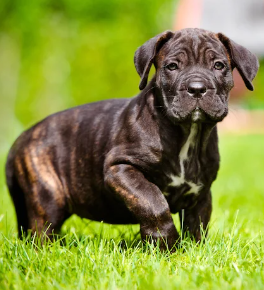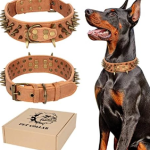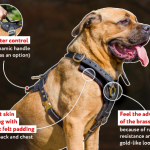cane corse
Introduction
The Cane Corso, a breed often characterized by its impressive stature and loyal nature, is rapidly gaining popularity among dog enthusiasts. Originating from Italy, this powerful and majestic breed is renowned for its strength, intelligence, and protective instincts. This comprehensive guide will explore the Cane Corso in depth, covering its history, physical characteristics, temperament, training requirements, health considerations, and more. Whether you are considering bringing a Cane Corso into your life or simply want to learn more about this fascinating breed, this article will provide you with a thorough understanding of what makes the Cane Corso so unique.
Chapter 1: History and Origins
1.1 Historical Background
The Cane Corso, also known as the Italian Mastiff, has roots that stretch back to ancient Rome. The breed’s history is closely tied to the ancient Molossian dogs, which were used by Roman soldiers and gladiators. These large, powerful dogs were renowned for their strength and bravery, qualities that have been passed down through generations.
During the Roman Empire, Molossian dogs were used for a variety of purposes, including guarding properties, herding cattle, and participating in combat. The Cane Corso’s ancestors were valued for their versatility and ability to perform various tasks, making them indispensable companions for the Romans.
1.2 Development in Italy
As the Roman Empire declined, the Molossian dogs evolved into several distinct breeds, including the Cane Corso. In Italy, the Cane Corso was refined and developed to meet the needs of local farmers and landowners. They were used primarily as guard dogs and hunting companions, known for their ability to protect livestock and their tenacity in the field.
By the 19th and early 20th centuries, the Cane Corso faced a decline in popularity due to changes in agricultural practices and the introduction of more specialized breeds. However, dedicated enthusiasts and breeders worked to preserve and revive the breed, leading to its recognition by major kennel clubs in the latter part of the 20th century.
1.3 Modern Recognition
The Cane Corso has gained significant recognition in recent decades. The breed was officially recognized by the American Kennel Club (AKC) in 2010, and it has since grown in popularity both in the United States and internationally. Modern Cane Corsos are valued for their impressive physical attributes, loyal nature, and versatility as both family pets and working dogs.
Chapter 2: Physical Characteristics
2.1 Size and Build
The Cane Corso is a large and muscular breed, with a well-defined, powerful physique. Here are some key characteristics:
- Size: Males typically weigh between 99 to 110 pounds (45 to 50 kg) and stand about 24 to 27.5 inches (61 to 70 cm) tall at the shoulder. Females are slightly smaller, generally weighing between 88 to 99 pounds (40 to 45 kg) and standing 23.5 to 26 inches (60 to 65 cm) tall.
- Build: The breed has a robust and athletic build, with a broad chest, strong legs, and a muscular back. The Cane Corso’s powerful appearance is complemented by its graceful movements and agility.
2.2 Coat and Color
The Cane Corso has a short, dense coat that provides protection from various weather conditions:
- Coat: The coat is close-lying and smooth, requiring minimal grooming. Regular brushing can help maintain its health and shine.
- Colors: Cane Corsos come in a range of colors, including black, gray, fawn, red, and brindle. Some variations may have subtle markings or patterns, but the breed’s coat should always be well-maintained and clean.
2.3 Facial Features
The Cane Corso’s face is one of its most striking features:
- Head: The breed has a broad, square-shaped head with a strong, defined jawline. The skull is slightly domed, and the muzzle is well-proportioned and powerful.
- Eyes: Cane Corsos have expressive, almond-shaped eyes that can be dark or light, depending on the coat color. The eyes convey the breed’s alert and intelligent nature.
- Ears: The ears are typically cropped in many countries, but natural ears are medium-sized and set high. Cropping is a personal choice and often done for aesthetic reasons or to adhere to breed standards.
Chapter 3: Temperament and Personality
3.1 General Temperament
The Cane Corso is known for its loyal and protective nature. Here’s a closer look at its temperament:
- Loyalty: Cane Corsos are deeply loyal to their families and form strong bonds with their owners. They are often described as being devoted and affectionate.
- Protectiveness: The breed has a strong protective instinct, making it an excellent guard dog. Cane Corsos are naturally wary of strangers and will protect their home and family if they sense a threat.
- Intelligence: Cane Corsos are highly intelligent and eager to please, which makes them relatively easy to train. They are quick learners and respond well to consistent, positive reinforcement.
3.2 Socialization and Interaction
Proper socialization is crucial for a Cane Corso to ensure it develops into a well-rounded adult dog:
- Early Socialization: Expose your Cane Corso to a variety of people, animals, and environments from an early age to help it develop good social skills. Positive experiences during this time will contribute to a balanced and confident adult dog.
- Family Interaction: Cane Corsos are generally good with children and can be affectionate family members. However, they should always be supervised around young children to ensure safe interactions.
- Interactions with Other Pets: Early socialization and proper training can help your Cane Corso get along well with other pets. However, the breed’s strong prey drive may require additional supervision when interacting with smaller animals.
3.3 Behavioral Traits
The Cane Corso’s behavior is influenced by its history as a working and guarding breed:
- Protective Instinct: The breed’s natural guarding instincts make it an excellent watchdog. Cane Corsos will alert their owners to any unusual activity and will take action if they perceive a threat.
- Energetic Nature: Cane Corsos are energetic and require regular exercise to stay healthy and happy. They enjoy activities such as running, hiking, and playing fetch.
Chapter 4: Training and Exercise
4.1 Training Basics
Training is essential for managing the Cane Corso’s powerful physique and strong will:
- Basic Commands: Start with basic commands such as sit, stay, and come. Use positive reinforcement techniques, including treats and praise, to encourage desired behaviors.
- Consistency: Consistency is key when training a Cane Corso. Establish clear rules and boundaries, and ensure that all family members are on the same page regarding training methods.
- Socialization: Continue socializing your Cane Corso throughout its life to reinforce good behavior and help it adapt to new situations and environments.
4.2 Advanced Training
Once your Cane Corso has mastered basic commands, consider advanced training:
- Obedience Training: Enroll your Cane Corso in advanced obedience classes to refine its skills and address any behavioral issues. Advanced training can also provide mental stimulation and enhance the bond between you and your dog.
- Agility Training: Agility training can be a fun and rewarding way to challenge your Cane Corso. It provides both physical exercise and mental stimulation, helping to keep your dog engaged and active.
4.3 Exercise Requirements
Cane Corsos are active dogs with high exercise needs:
- Daily Exercise: Provide your Cane Corso with at least 1 to 2 hours of exercise each day. Activities such as walking, running, and playing fetch are essential for maintaining their physical and mental health.
- Mental Stimulation: In addition to physical exercise, incorporate mental stimulation into your Cane Corso’s routine. Puzzle toys, interactive games, and training sessions can help keep your dog’s mind sharp.
Chapter 5: Health and Care
5.1 Common Health Issues
Like all breeds, Cane Corsos are prone to certain health conditions:
- Hip Dysplasia: This genetic condition affects the hip joint and can lead to arthritis or lameness. Regular veterinary check-ups and maintaining a healthy weight can help manage this condition.
- Elbow Dysplasia: Similar to hip dysplasia, elbow dysplasia affects the elbow joint and can cause pain and mobility issues. Early diagnosis and treatment are important for managing this condition.
- Bloat (Gastric Dilatation-Volvulus): Bloat is a serious condition where the stomach fills with gas and can twist, leading to a medical emergency. To reduce the risk, avoid feeding large meals and exercise your Cane Corso after meals.
5.2 Preventive Care
Maintaining your Cane Corso’s health involves regular preventive care:
- Veterinary Check-Ups: Schedule regular veterinary check-ups to monitor your dog’s health and address any potential issues early.
- Vaccinations: Keep up with vaccinations to protect your Cane Corso from common canine diseases.
- Parasite Prevention: Use preventive medications to protect your dog from fleas, ticks, and heartworms.
5.3 Grooming and Maintenance
The Cane Corso’s grooming needs are relatively low compared to some other breeds:
- Brushing: Regular brushing, about once a week, helps remove loose hair and keeps the coat healthy.
- Bathing: Bathe your Cane Corso as needed, typically every few months or when it becomes dirty. Use a dog-friendly shampoo to avoid skin irritation.
- Nail Trimming: Regularly trim your Cane Corso’s nails to prevent overgrowth and discomfort.
5.4 Diet and Nutrition
A balanced diet is crucial for your Cane Corso’s overall health:
- High-Quality Dog Food: Choose a high-quality dog food formulated for large breeds. Ensure it meets your Cane Corso’s nutritional needs and supports its overall health.
- Portion Control: Follow feeding guidelines based on your Cane Corso’s age, weight, and activity level. Monitor its weight and adjust portions as needed to maintain a healthy body condition.
Chapter 6: Choosing a Cane Corso
6.1 Finding a Reputable Breeder
When choosing a Cane Corso, it is essential to find a reputable breeder:
- Research: Look for breeders who are members of recognized breed clubs and have a track record of ethical breeding practices.
- Health Testing: Ensure the breeder conducts health testing on their breeding dogs for conditions such as hip dysplasia and elbow dysplasia.
- References: Ask for references from previous buyers to gauge the breeder’s reputation and the quality of their puppies.
6.2 Adoption and Rescue
Consider adopting a Cane Corso from a rescue organization:
- Breed-Specific Rescues: Look for Cane Corso rescue organizations or breed-specific rescues that specialize in finding homes for abandoned or surrendered Cane Corsos.
- Adoption Process: The adoption process typically involves an application, interview, and home visit to ensure a good match between the dog and its new family.
6.3 Preparing for Your New Cane Corso
Once you have chosen a Cane Corso, prepare for its arrival:
- Home Setup: Create a comfortable space for your new dog, including a bed, food and water bowls, and toys.
- Family Introduction: Introduce your Cane Corso to family members and other pets gradually to ensure a smooth transition.
- Initial Veterinary Visit: Schedule an initial veterinary visit to establish a health care routine and address any immediate needs.
Chapter 7: Cane Corso in Popular Culture
7.1 Media Appearances
The Cane Corso has made several appearances in popular media:
- Movies and TV Shows: The breed has been featured in films and television shows, often highlighting its impressive appearance and protective nature.
- Social Media: Cane Corsos are popular on social media platforms, where their loyal and majestic traits are showcased through photos and videos.
7.2 Breed in the Community
Cane Corsos are involved in various community activities:
- Dog Shows: The breed often participates in dog shows, where they are judged based on their adherence to breed standards and overall presentation.
- Working Roles: Cane Corsos are employed in various working roles, including as guard dogs and in search and rescue operations, due to their intelligence and trainability.
Conclusion
The Cane Corso is a breed of great strength, loyalty, and versatility. With its rich history, impressive physical attributes, and dedicated nature, the Cane Corso makes a remarkable companion for those who can meet its needs. From understanding its origins and physical characteristics to learning about its temperament, training requirements, and health considerations, this comprehensive guide provides valuable insights into what it takes to care for and appreciate this magnificent breed. Whether you are considering adding a Cane Corso to your family or simply admiring it from afar, this guide serves as a testament to the breed’s unique qualities and enduring appeal.






